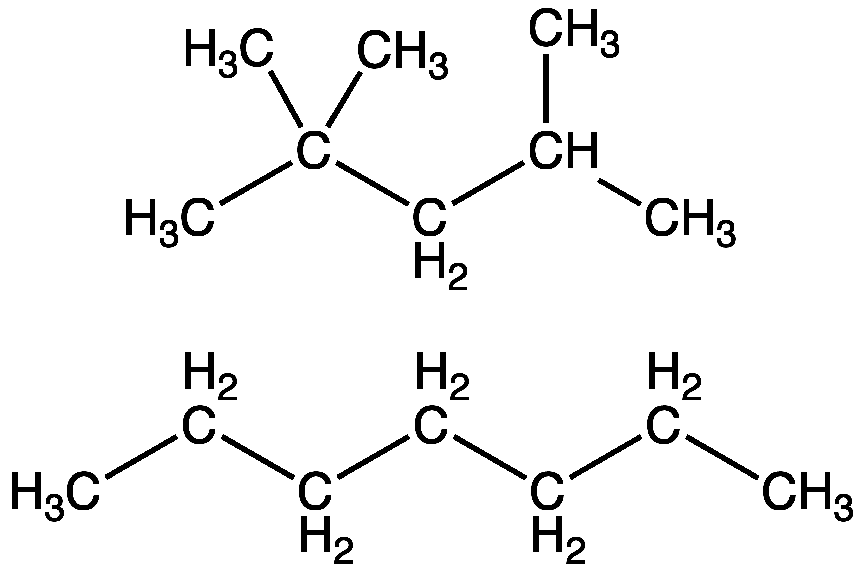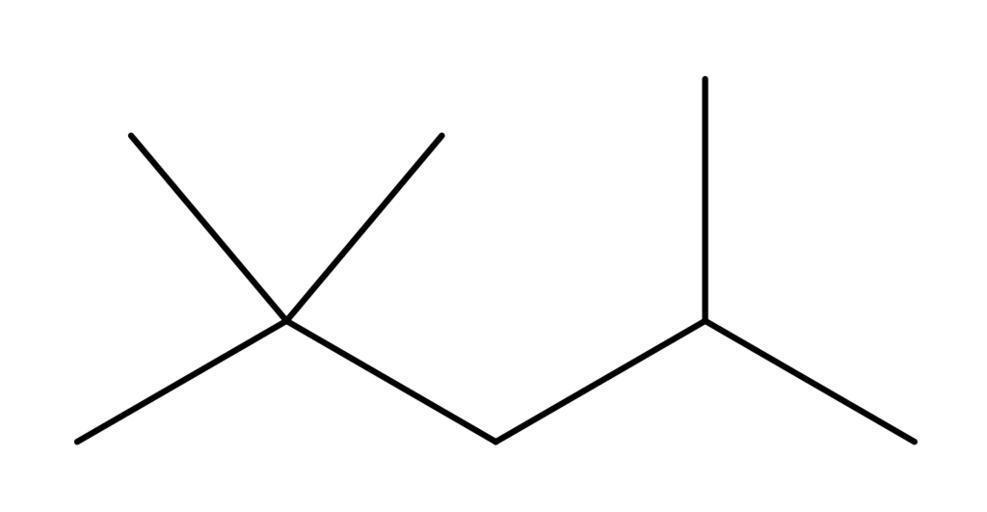
Write the complete structural formula, condensed structural formula and bond line formula of iso-octane.
Answer
400.2k+ views
Hint :Electrons reside outside of the nucleus of an atom and are found in major energy levels with only a limited amount of electrons. The valence level is the outermost main energy level that contains electrons, and it contains valence electrons. Lewis symbols are diagrams that illustrate the number of valence electrons in a certain element together with lone pairs represented by dots.
Complete Step By Step Answer:
The chemical molecule 2,2,4-trimethylpentane, sometimes known as iso octane or iso-octane, has the formula $ {\left( {{\text{C}}{{\text{H}}_3}} \right)_3}{\text{CC}}{{\text{H}}_2}{\text{CH}}{\left( {{\text{C}}{{\text{H}}_3}} \right)_2} $ . It's one of numerous octane isomers ( $ {C_8}{H_{18}} $ ). On the octane rating scale, this isomer is the typical 100 point (the zero point is n-heptane). It is a significant component of gasoline, and it is typically used in rather high amounts to improve the fuel's knock resistance.
A way of writing organic structures in a line of text is known as a condensed structural formula. All atoms are visible, but the vertical bonds and most or all horizontal single bonds are missing. It uses parentheses to indicate that polyatomic groups in a formula are connected to the non-hydrogen atom on the left. Covalent bonds are represented with one line for each degree of bond order in a bond-line structure, which is a depiction of molecular structure. A chemical compound's structural formula is a pictorial depiction of the molecular structure, indicating how the atoms could be placed in three-dimensional space.
Complete structural formula:

Bond line formula:

Condensed formula: $ {\left( {{\text{C}}{{\text{H}}_3}} \right)_3}{\text{CC}}{{\text{H}}_2}{\text{CH}}{\left( {{\text{C}}{{\text{H}}_3}} \right)_2} $ .
Note :
Engine knocking is an undesired phenomenon that can occur in internal combustion engines with high compression ratios. In 1926, Graham Edgar experimented with varying quantities of n-heptane and 2,2,4-trimethylpentane in gasoline and discovered that when 2,2,4-trimethylpentane was introduced, the knocking ceased. The octane rating scale was born out of this research.
Complete Step By Step Answer:
The chemical molecule 2,2,4-trimethylpentane, sometimes known as iso octane or iso-octane, has the formula $ {\left( {{\text{C}}{{\text{H}}_3}} \right)_3}{\text{CC}}{{\text{H}}_2}{\text{CH}}{\left( {{\text{C}}{{\text{H}}_3}} \right)_2} $ . It's one of numerous octane isomers ( $ {C_8}{H_{18}} $ ). On the octane rating scale, this isomer is the typical 100 point (the zero point is n-heptane). It is a significant component of gasoline, and it is typically used in rather high amounts to improve the fuel's knock resistance.
A way of writing organic structures in a line of text is known as a condensed structural formula. All atoms are visible, but the vertical bonds and most or all horizontal single bonds are missing. It uses parentheses to indicate that polyatomic groups in a formula are connected to the non-hydrogen atom on the left. Covalent bonds are represented with one line for each degree of bond order in a bond-line structure, which is a depiction of molecular structure. A chemical compound's structural formula is a pictorial depiction of the molecular structure, indicating how the atoms could be placed in three-dimensional space.
Complete structural formula:

Bond line formula:

Condensed formula: $ {\left( {{\text{C}}{{\text{H}}_3}} \right)_3}{\text{CC}}{{\text{H}}_2}{\text{CH}}{\left( {{\text{C}}{{\text{H}}_3}} \right)_2} $ .
Note :
Engine knocking is an undesired phenomenon that can occur in internal combustion engines with high compression ratios. In 1926, Graham Edgar experimented with varying quantities of n-heptane and 2,2,4-trimethylpentane in gasoline and discovered that when 2,2,4-trimethylpentane was introduced, the knocking ceased. The octane rating scale was born out of this research.
Recently Updated Pages
The main scale of a Vernier caliper reads 10mm in 10divisions class 11 physics CBSE

A metallic block of density 5 gmcm3 and having dimensions class 11 physics CBSE

The Indian Constitution is regarded as A Federal B class 11 social science CBSE

Number of the possible geometrical isomers for 13 pentadiene class 11 chemistry CBSE

How far away from the surface of the earth does the class 11 physics CBSE

As shown in the figure the amount of heat absorbed class 11 physics CBSE

Trending doubts
The reservoir of dam is called Govind Sagar A Jayakwadi class 11 social science CBSE

10 examples of friction in our daily life

What problem did Carter face when he reached the mummy class 11 english CBSE

Difference Between Prokaryotic Cells and Eukaryotic Cells

State and prove Bernoullis theorem class 11 physics CBSE

Proton was discovered by A Thomson B Rutherford C Chadwick class 11 chemistry CBSE




